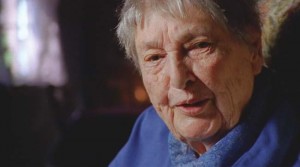Ken Burns’s most recent documentary, “The Dust Bowl,” which premiered in November on PBS, interviews 26 survivors of what he calls the worst man-made ecological disaster in American history. Among those interviewed is a 21-year-old social worker who recently graduated from college.
That young social worker is Dorothy Christenson Williamson ’34, and the college is Colorado College. Williamson, who turns 100 this month, credits Sociology Professor Alice Van Diest with steering her toward a job with the Federal Emergency Relief Administration (FERA). Upon graduating magna cum laude with a history degree, Williamson received a scholarship for graduate studies in the newly emerging field of social work at Case Western Reserve University. She attended the six-month program on the recommendation of Van Diest, who was a consultant to FERA.
“They needed people with casework experience. I remember her sending me a telegram when I got the job, telling me to proceed immediately by auto to Lamar. Well, I had no auto, so I proceeded by bus,” Williamson said. Lamar was the county seat of Prowers County in southeastern Colorado, the western edge of the Dust Bowl. Williamson started working in the area in Spring 1935, calling on outlying farms and distributing government commodities such as dried milk, butter, and cheese.
Williamson recalls visiting the hard-hit residents of Prowers County and sitting across from them at their kitchen tables. “They couldn’t believe what was happening to them. It wasn’t anything that anyone had experienced before,” she said. “It was black, black, black everywhere. If you left your shoes at night and didn’t turn them upside down, they would be full of sand in morning.
“People were stunned; they looked hopeless. They were in the middle of something they could see no way out of. They needed to trust again in something that they had lost. They needed an inner thing that nobody could give them,” Williamson said.
The temperature in Lamar often rose to 114 degrees. Williamson couldn’t go out when a dust storm enveloped the area, and recalls animals smothered by the dirt in their noses and mouths. She earned $18.50 a week — which included a five-day workweek and a half day on Saturdays. She had a room in an older couple’s home and took her meals at the nearby Lamar Hotel. Her weekly treat: “Going to the drugstore to get an ice-cold lime-aid. It tasted so good.”
Williamson’s work with FERA was interrupted by an emergency appendectomy in April 1935. The nurse at the Lamar hospital told Williamson that it was fortunate the dust wasn’t blowing too badly that day, or they would not have been able to perform the surgery. During Williamson’s month-long recovery, the nurses taped wet sheets to the windows and doors. In the morning, the only place that wasn’t covered with dust was where her head had laid on the pillow.
Williamson met her husband in Lamar, and after their marriage in December 1935, she moved to Denver and continued her career at the Denver Department of Welfare. Her daughters, Karen Williamson Andrews ’62 and Kristin Williamson Adcock ’67, and granddaughter Amelia Adcock ’00 are all CC graduates, as was her brother, the late Alton (“Chris”) Christenson ’35.
When Williamson graduated from Colorado College 78 years ago, she was the only history major in her class of less than 100. Going to college was unusual for a female in the 1930s, in the middle of the Depression, but it was a given in her family that she and her brother would attend college.
She was able to attend CC in the depths of the Depression with the help of various scholarships. She was a Freshman Scholar under a CC program, which offered tuition for entering first-year college students. Her tuition for the next year was paid by a Woman’s Educational Society scholarship. During her sophomore year, she placed second in the nation on an intelligence test conducted by the Carnegie Foundation for the Advancement of Teaching, which was given to 16,000 students. Williamson missed the top score by .3 of a point. (The top score was earned by another CC student.) During her junior and senior years, she won the Perkins Prize in history, which was sufficient to cover her tuition and fees.
Williamson remembers many professors who inspired and opened up the world to her. “Whatever they put out, I lapped up,” she said. Looking back on her education now, she is surprised at how many were women.
Williamson appreciates the fact that she is, in some way, a part of history. “It astounds me to be this old, and being in a film. Being a history major, I’m glad I had a long life — I get to see history unfold right in front of my eyes. I had no conception that I would be a little tiny part of it. I lived through it, but didn’t understand until later that it was a great accomplishment.”
The filming of the documentary two years ago brought back a lot of Dust Bowl memories. “I still feel terrible for the people, and all the animals. They didn’t really know what was happening. But these people, they went about their ordinary business in Lamar, with nothing left for them. None of the people I called on ever left; they stayed and lived through it. Whatever faces you, you have to go through, and some people do it better than others. But I would have been glad to have known what happened to those people.”
Although homebound now, Williamson had been a community volunteer in Denver participating in numerous civic projects. She took an active part in the American Association of University Women, chairing several groups.
“I was always glad I majored in history,” she said. “It gave me lifelong interests that I still have today, in reading and such. It’s interesting when I look back on my life; interesting to have lived through those times.”
